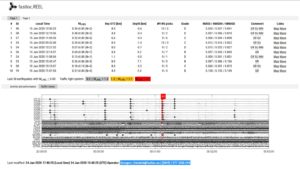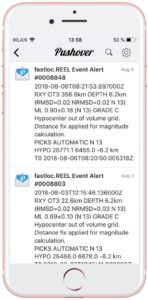
fastloc.REEL(-AI) is a commerial software package developed by myself for fastloc GmbH for near-realtime analysis of induced seismicity using online waveform data recorded with local-to-regional seismic networks. Currently, there are two versions of the software available to the customers:
- fastloc.REEL is the centerpiece of the software written in C++ designed to perform highly efficient near-realtime processing of (micro)seismic data. The main feature here is the capability of processing a large number of seismic channels at high sampling rates (even up to 1MHz). This version was successfully used during monitoring and analysis of the 2018 stimulation in Helsinki suburban area in the frame of St1 Deep Heat project.
- fastloc.REEL-AI is the new version of the software created in Matlab and C++. This version implements state-of-the art deep learning techniques to identify and further process induced seismicity data in near-realtime. It is expected to ultimately supersede the initial fastloc.REEL software. This new version has a modular structure and it can be quickly adapted to customer needs.
Regardless of the core version, the fastloc.REEL software package is associated by (optional) modules that can be configured and fitted to the customer needs. This includes:
- A database access module allowing to access fastloc.REEL(-AI) processing data by any respective software of the customer. For example, onsite traffic-light system operators may directly use the microseismicity catalog created in near-realtime by fastloc.REEL e.g. to calculate seismic hazard related characteristics.
- A dashboard module allowing to present relevant information from processing of microseismicity data for the customer. This includes but is not limited to information on the seismicity catalog itself, graphical representation of spatial and temporal development of induced seismicity.
- A messaging module that uses the third-party mobile application Pushover to send sensitive information in near-realtime to the customer. For example, the information on larger seismic events can be sent directly onto mobile phones of traffic-light system operators or to the hydraulic stimulation team. These messages can be also sent via email.
- A fastloc.FOCI module provides an additional software package that allows to manually process seismic data (e.g. for P- and S- phase re-picking, moment tensor inversion, source parameters assessment).
The description of fastloc.REEL modules is provided below in greater details. The software is capable to operate on regular PC running Microsoft Windows.
Use case scenarios
- Near-realtime monitoring of seismic reservoir response due to exploitation of georesources.
- Providing information on spatial and temporal development of induced seismicity necessary for traffic-light system operations and for seismic hazard assessment.
- Aide in guiding engineering operations at the site by providing feedback to engineering teams.
Technical characteristics
fastloc.REEL(-AI) core module
- Near real-time processing of seismic waveform data for the purpose of hypocenter determination of induced seismic events (absolute and high-precision relative relocation) and calculation of their source parameters.
- Complementary handling of local and regional seismic networks operating even at extremely high sampling rates of up to 1MHz.
- Capable of reading all regular data formats such as but not limited to miniSEED, PASSCAL Trace SEG-Y, ASCII.
- Fully configurable preprocessing of seismic signals (such as filtering, detrending etc.).
- Automatic picking of P- and S-wave onset times using STA/LTA trigger, Akaike Information Criterion or Deep Learning techniques.
- Phase association and location of seismic data using the EDT (Equivalent Differential Time) method. Numerous optimization techniques can be used and stacked in processing cascades including grid search, simplex, metropolis-hastings random walk algorithm and simulated annealing optimization. To determine earthquake hypocenter, the isotropic, 1D-velocity model or per-station velocity model can be used. All such steps are operated on a case-by-case optimization procedure.
- Adaptation of preferred magnitude scale (local, moment, other).
- Relative relocation of seismic events using the hypoDD (Waldhauser & Ellsworth, 2000) software package.
- All generated data are stored in customer-defined format and can be used by third-party software or e.g. the fastloc.FOCI application for further manual and automated processing.
Optional modules
Dashboard module

Messaging module
Our messaging module uses an easy-to-handle notification system called ‘Pushover’ to provide important information related to processing seismic data. This is crucial e.g. in case of increasing magnitudes of induced seismicity requiring immediate response and activation of a feedback system to eventually modify injection protocols by the hydraulic team and/or traffic-light system operators. This information can be sent to mobile phones as push messages or by email.
Database access module

Foci module
This module integrates FOCI application with fastloc.REEL software. The fastloc.FOCI is a separate program that allows to manualy re-process seismic data provided by fastloc.REEL. The program can be used to improve the P- and S- phase onsets, perform moment tensor inversion or source parameters estimation. The detailed information on fastloc.FOCI is presented here.
Software and hardware requirements
The requires Microsoft Windows 7/8/8.1 operating system installed. The recommended hardware configuration includes SSD drive and at least 8GM of internal memory. The software is protected using an USB license dongle.
Contact / questions
For inquiries regarding the commertial use of the software please see the dedicated fastloc GmbH contact page.